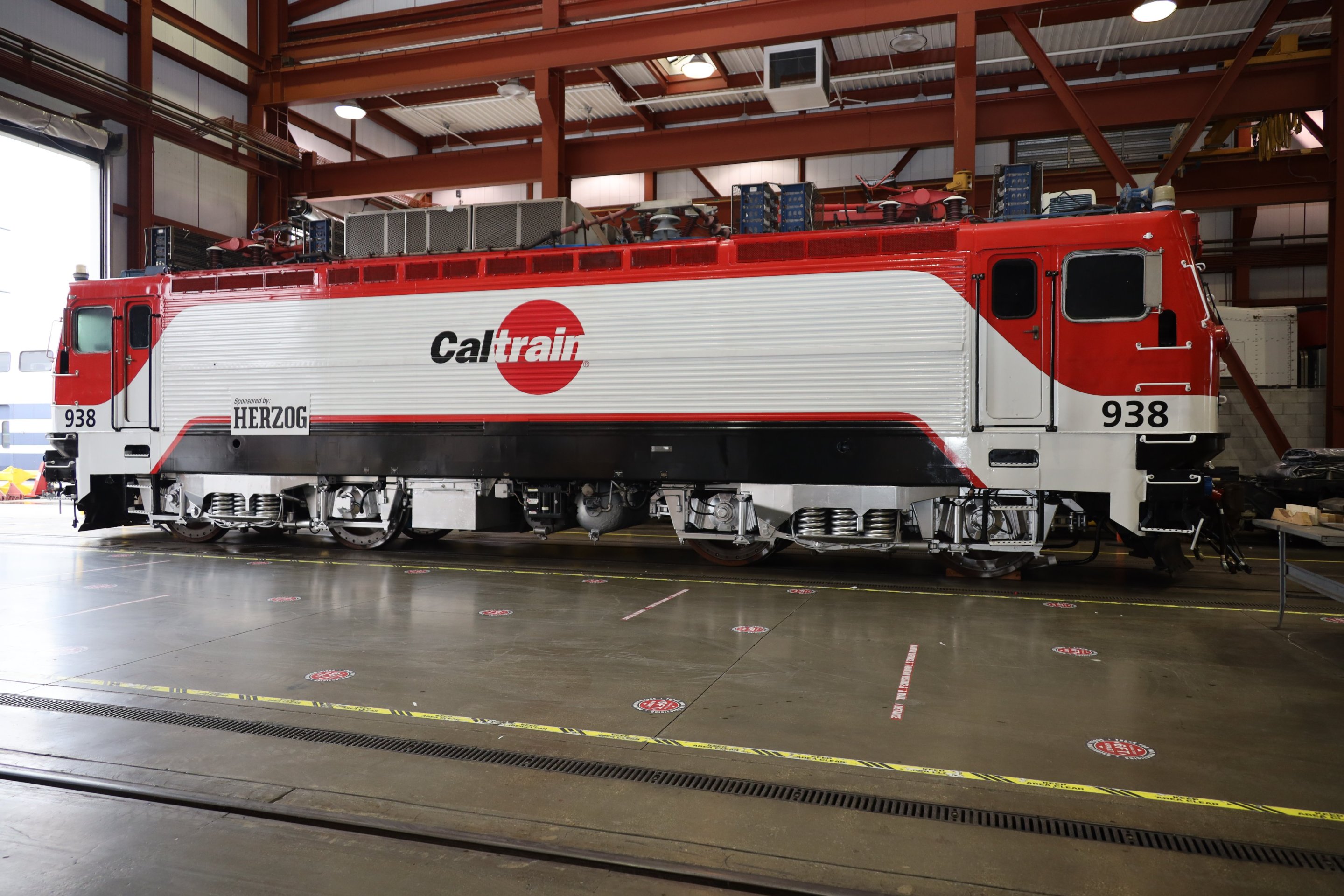Caltrain Governance Negotiations Inch Forward
1:17 PM PST on February 7, 2022

Caltrain’s AEM-7 electric locomotive. Image from Caltrain’s Twitter
Editor’s Note: this article originally appeared in Green Caltrain and is republished with permission.
The Caltrain board inched forward in painstaking negotiations on 3-county governance at its meeting on Thursday. The matter is now in the hands of a 3-person board subcommittee to work on remaining outstanding issues before the next board meeting in March. The board made enough progress that a tentatively scheduled governance workshop on February 9th was removed from the calendar.
Issues settled and unsettled
Major issues including a dedicated executive director reporting to the Caltrain board, and repayment of the $19.8 million due to SamTrans for purchasing the right of way formally agreed in 2008 appear to have been agreed. The proposal to hire and fire the executive via majority vote with at least one representative per county seemed to be supported by the board members. MTC had resolved the previous week to program the $19.6 million in funds due from that body, and Executive Director Michelle Bouchard reported that the City/County of San Francisco has expressed commitment to their $200K.
There was still an hour-long discussion about the specific timing by which the MTC would commit funds, which will apparently be done by funding projects for which SamTrans seeks regional funding. The MTC had voted to program the funds in 2022 with an “accelerated goal” of making a recommendation by June. In its formal statement, the SamTrans board demanded payment within six months of the approval of an agreement. Various board members suggested alternative dates, and Chair Heminger observed that the timing debate may well be moot given the time needed to reach and confirm agreement.
There was an interlocking set of unresolved issues relating to the specifics of the number of dedicated employees and formality of continued service sharing; and additional payment that SamTrans is seeking as compensation for diminished managing agency powers.
In addition to the ED role, there are already 105 staff working exclusively on rail at the direction of the Caltrain executive director. Caltrain staff have recommended bringing on 6 additional staff, and SamTrans’ position did not support these additional roles.
Beyond the dedicated positions, there are 104 employees providing shared services in areas such as Human Resources and IT (not including the people who work on the trains, whose contract with Transportation Services of America is not affected by these negotiations). Caltrain staff had recommended an explicit shared service agreement that can be revisited and adjusted periodically; the SamTrans board letter did not oppose the concept of an explicit shared service agreement, but did not want the creation of such an agreement to be a prerequisite of the current deal. During the meeting, Chair Heminger proposed establishing a date to create a shared services agreement.

Beyond the $19.8 million outstanding according to the terms of the 2008 agreement, SamTrans is seeking $15.2 million in light of the long period of time since the agreement in 2008, and as compensation for giving up some of SamTrans’ managing agency powers.
Several board members observed that they saw the issues as interrelated, including seeing the amount of money as being related to the decision about a greater or lesser amount of service sharing. Because board members saw the issues as interrelated, they held off on motions to approve specific issues until there was a final deal to support.
In the hands of a subcommittee
At the end of the meeting, Director Heminger delegated additional negotiations to a subcommittee from members of each county; Director Gee from San Mateo County, Director Davis from Santa Clara County, and Heminger from San Francisco. Since the debates regarding getting Measure RR on the ballot, these members were among those with pragmatic stances rather than heated rhetoric, so that adds promise to the prospect of negotiation progress. Grace Crunican, former BART General Manager is being brought in to facilitate.
Some board members questioned whether a subcommittee was a viable path, because negotiations in an earlier subcommittee had broken down; and also questioning whether the members were empowered to negotiate for their county partner. Director Walton observed that progress had been made on multiple issues since the earlier breakdown of negotiations.
Regarding the power to negotiate, Director Davis noted that while members from Santa Clara County had not been explicitly appointed by VTA to negotiate, they are seen by their colleagues as most knowledgeable about Caltrain, and therefore are well positioned to go back to the VTA board to persuade their colleagues to support an agreement. In response to a question to SamTrans GM Mau as to whether SamTrans positions were final, he replied that he would look to the SamTrans members of the Caltrain regarding which items to negotiate. On at least one of the topics Director Gee noted that SamTrans would consider counteroffers.
Director Walton, who is the representative of the City/County of San Francisco delegated the negotiating role to Director Heminger, which is especially promising. Director Walton declined Heminger’s offer to serve on the subcommittee, due to Walton’s role as San Francisco board president in budget season. Until this meeting, Walton had consistently maintained a firm position in favor of full separation from SamTrans, which had been rejected by the earlier board members due to cost.
Goodwill and snacks
Board members, including those who had previously staked out the strongest positions, encouraged goodwill. Director Chavez observed at the outset that board members had got tired, hungry, and grouchy at the previous long governance discussions, and wanted her colleagues to think about having snacks at hand and treating each other with kindness.
Urging a speedy resolution
Many public comments, including from your blogger, urged the board to reach a speedy resolution, in order to move on to deal with important challenges and opportunities, including funding and completion of Caltrain electrification; pursuing ridership recovery and dealing with the financial challenges posed by the pandemic; and engaging in ongoing regional processes relating to transit coordination and regional rail governance.
A few public comments forcefully observed that the amounts being negotiated in the range of $15 million, and 6 out of 200 employees, were small in comparison to the major issues facing Caltrain – such as the $400 million needed to complete electrification, the upcoming fiscal cliff when federal relief funds run out, and the severity of the climate crisis for which high-ridership transit is crucial.
Read More:
Stay in touch
Sign up for our free newsletter
More from Streetsblog San Francisco
Valencia Merchants to SFMTA: We Want Curbside Protected Bike Lanes
Valencia merchants association strengthens support for getting rid of the failed center-running bike lane and replacing it as soon as possible with curbside protected lanes
S.F. Fire Apologizes for Tweeting About Imaginary Bike Rule
There is no rule in California that says cyclists have to ride single file




